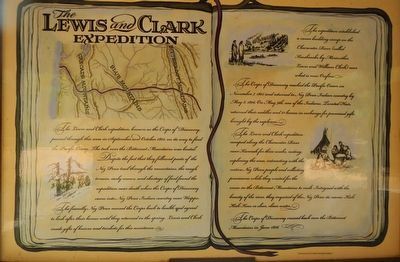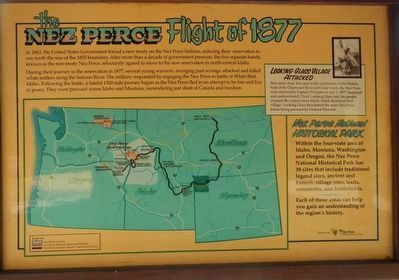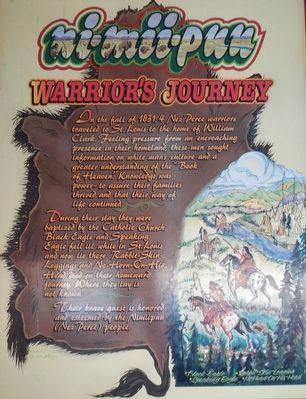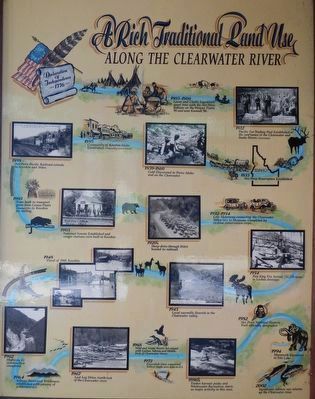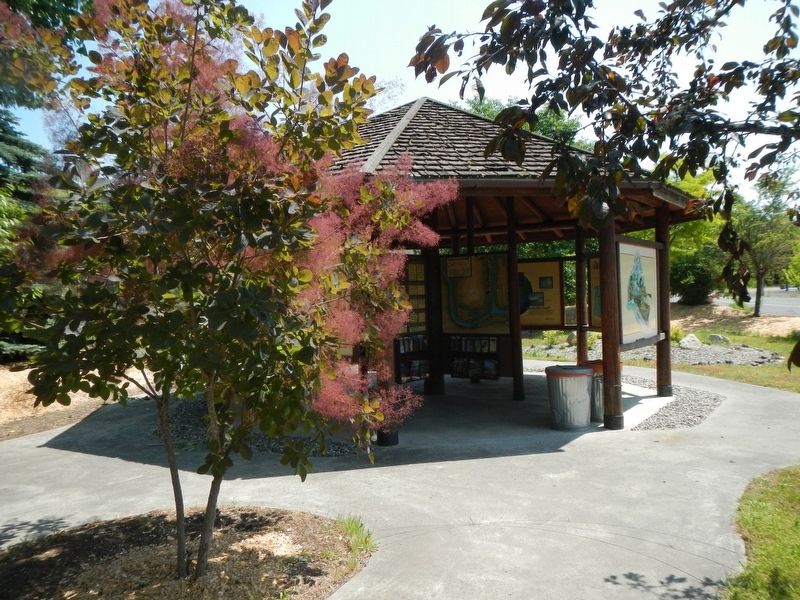Kooskia in Idaho County, Idaho — The American West (Mountains)
Kooskia Crossing Kiosk
The Lewis and Clark expedition known as the Corps of Discovery, passed through this area in September and October of 1805, on its way to find the Pacific Ocean. The trek over the Bitterroot Mountains was brutal. Despite the fact that they followed parts of the Nez Perce trail through the mountains, the rough terrain, early snows, and shortage of food found the expedition near death when the Corps of Discovery came into Nez Perce Indian country near Weippe. The friendly Nez Perce nursed the Corp back to health and agreed to look after their horses until they returned in the spring. Lewis and Clark made gifts of knives and trinkets for their assistance.
The expedition established a canoe building camp on the Clearwater River (called Kooskooske by Meriwether Lewis and William Clark) near what is now Orofino
The Corps of Discovery reached the Pacific Ocean on November 7, 1805 and returned to Nez Perce Indian country by May 8, 1806. On May 9th, one of the Indians, Twisted Hair, returned their saddles and 21 horses in exchange for promised gifts brought by the explorers.
The Lewis and Clark expedition camped along the Clearwater River near Kamiah for three weeks, resting, exploring the area, interacting with the native Nez Peace people and collecting provisions while they waited for the snow in the Bitterroot Mountains to melt. Intrigued with the beauty of the river, they inquired of the Nez Perce its name: Kich Kich Koos or clear clean water.
The Corp of Discovery crossed back over the Bitterroot Mountains in June 1806.
In 1863, the United States Government forced a new treaty on the Nez Perce Indians, reducing their reservation to one tenth the size off the 1855 boundary. After more than a decade of government pressure, the five separate bands, known as the non-treaty Nez Perce, reluctantly agreed to move to the new reservation in north-central Idaho.
During their journey to the reservation in 1877, several young warriors, avenging past wrongs, attacked and killed white settlers along the Salmon River. The military responded by engaging the Nez Perce in battle at White Bird, Idaho. Following the battle, a fateful 1300 mile journey began as the Nez Perce fled in an attempt to be free and live in peace. They were pursued across Idaho and Montana, surrendering just short of Canada and freedom.
Looking Glass Village Attacked
Two miles from this spot at the confluence of the Middle Fork of the Clearwater and Clear Creek, the Nez Perce were attacked by Captain Whipple on July 1, 1877. Surprised and outnumbered, Chief Looking Glass and his people escaped the unprovoked attack which destroyed their village. Looking Glass then joined the main Nez Perce force being pursued by General Howard.
Nez Perce National Historical Park
Within the four-state area of Idaho, Montana, Washington and Oregon, the Nez Perce National Historical Park has 38 sites that included traditional legend sites, ancient and historic village sites, trails, cemeteries, and battlefields. -- Each of these areas can help you gain an understanding of the region's history.
Warrior's Journey
In the fall of 1831, 4 Nez Perce warriors traveled to St. Louis to the home of William Clark. Feeling pressure from an encroaching presence in their homeland, these men sought information on white man's culture and a greater understanding of the "Book of Heaven." Knowledge was power - to assure their families thrived and that their way of life continued.
During their stay they were baptized by the Catholic Church. Black Eagle and Speaking Eagle fell ill while in St. Louis and now lie there. Rabbit-Skin-Leggings and No-Horn-On-His-Head died on their homeward journey. Where they lay is not known.
Their brave quest is honored and esteemed by the Nimmipuu (Nez Perce) people.
Along the Clearwater River
(a timeline)
1776 Declaration of Independence 1805-1806 Lewis and Clark's Expedition spent time with the Nez Perce Indians on the Weippe Prairie '05 and near Kamiah '06 1812 Pacific Fur Trading Post Established at the confluence of the Clearwater and Snake Rivers. (Lewiston) 1855 Nez Perce Reservation Established 1859-60 Gold Discovered in Pierce Idaho and on the Clearwater 1895 Community of Kooskia Idaho Established. (Originally named Stuart) 1898 Northern Pacific Railroad extends to Kooskia and Stites. 1903 Tram built to transport grain from Camas Prairie (Grangeville) to Kooskia for milling. 1905 National Forests Established and ranger stations were built in Kooskia. 1920s Sheep driven through Stite's headed to railroad. 1932-1934 Lolo Motorway connected the Clearwater Valley (Id.) to Montana. Completed by civilian conservation corps. 1934 Pete King Fire burned 252,250 acres in Lochsa drainage. 1945 Local sawmills flourish in the Clearwater valley. 1948 Flood of 1948, Kooskia 1962 Highway 12 construction completed. 1964 Selway-Bitterroot Wilderness established with passing of wilderness act. 1967 Last Log Drive, North Fork of the Clearwater river. 1968 Wild and Scenic Rivers Act passed with Lochsa, Selway and Middle Fork of Clearwater rives. 1972 Dworshak Dam completed. Tallest single axis dam in U.S. 1980's Timber harvest peaks and Whitewater Recreation starts as major activity in this area. 1982 Nez Perce National Historical Trail officially designated. 1994 Mammoth discovered in Tolo Lake. 2002 Significant salmon run returns up the Clearwater river.
Erected by City of Kooskia.
Topics and series. This historical marker is listed in these topic lists: Exploration • Native Americans • Wars, US Indian. In addition, it is included in the Lewis & Clark Expedition, and the The Nez Perce Trail series lists.
Location. 46° 8.885′ N, 115° 58.936′ W. Marker is in Kooskia, Idaho, in Idaho County. Marker is at the intersection of U.S. 12 and State Highway 13, on the left when traveling east on U.S. 12. Touch for map. Marker is in this post office area: Kooskia ID 83539, United States of America. Touch for directions.
Other nearby markers. At least 8 other markers are within 6 miles of this marker, measured as the crow flies. History of a Frontier Community (approx. 0.6 miles away); Looking Glass (approx. 1.6 miles away); Trails at Heart of the Monster (approx. 4½ miles away); Nez Perce National Historical Park (approx. 4½ miles away); Nez Perce War (approx. 5 miles away); Long Camp (approx. 5.3 miles away); Asa Smith Mission (approx. 5.3 miles away); Lewis and Clark Route (approx. 5.3 miles away). Touch for a list and map of all markers in Kooskia.
More about this marker. The kiosk is located at a rest area found at the intersection of U.S. Highway 12 and Idaho Highway 13 in Kooskia, Idaho
Credits. This page was last revised on August 8, 2018. It was originally submitted on August 8, 2018, by Barry Swackhamer of Brentwood, California. This page has been viewed 384 times since then and 44 times this year. Photos: 1, 2, 3, 4, 5. submitted on August 8, 2018, by Barry Swackhamer of Brentwood, California.
